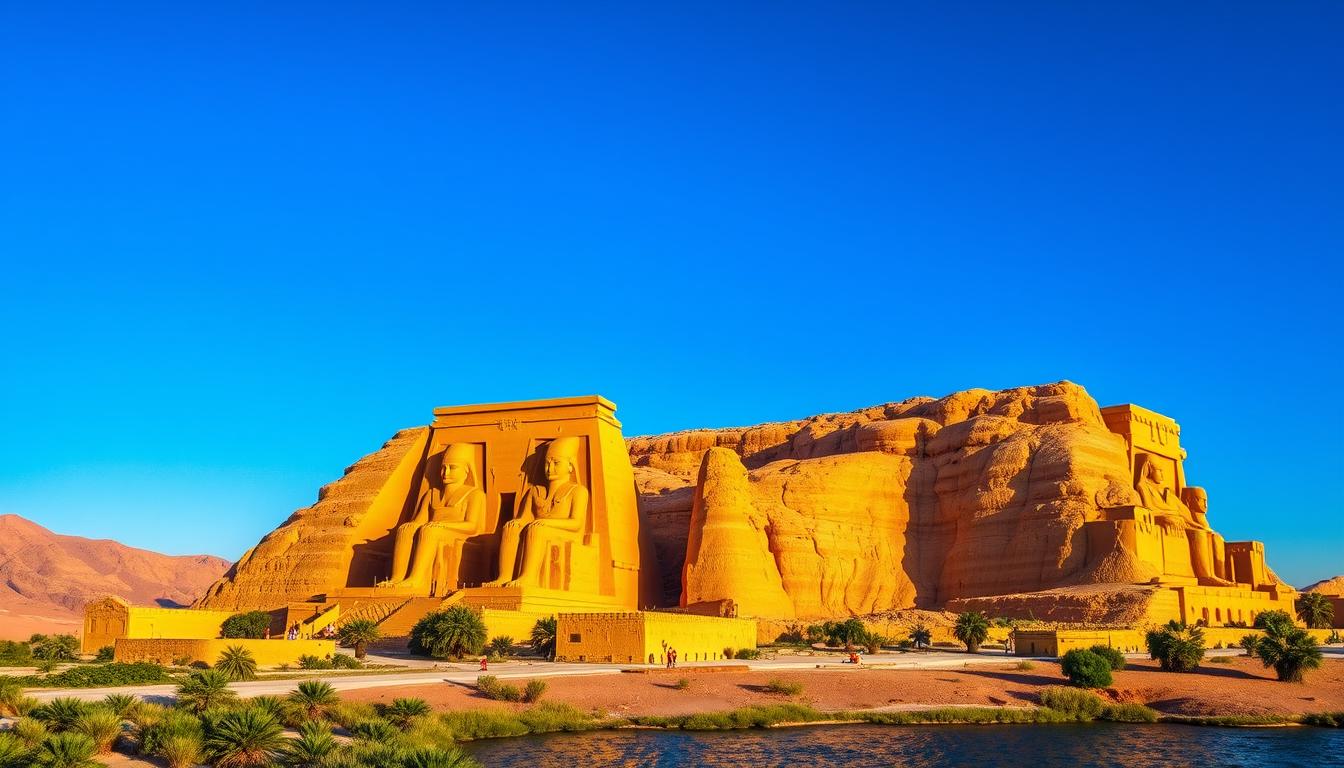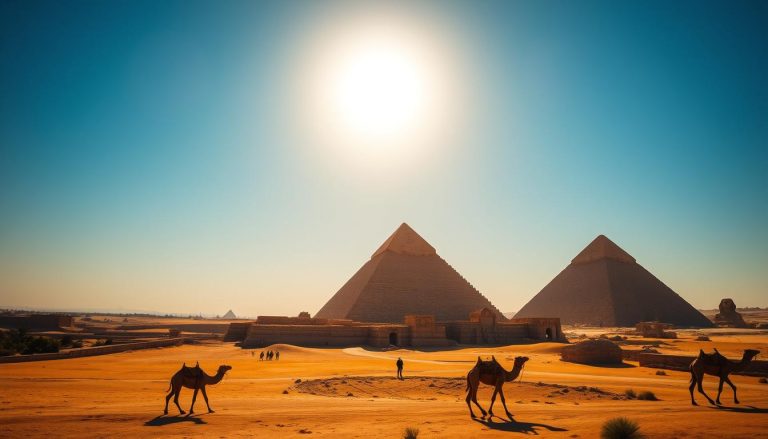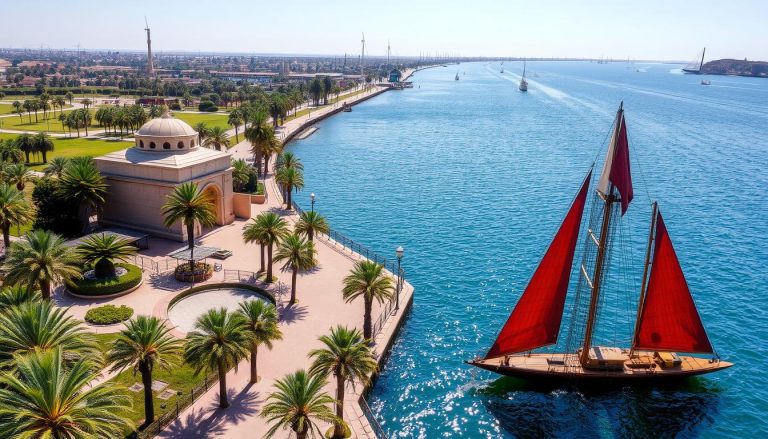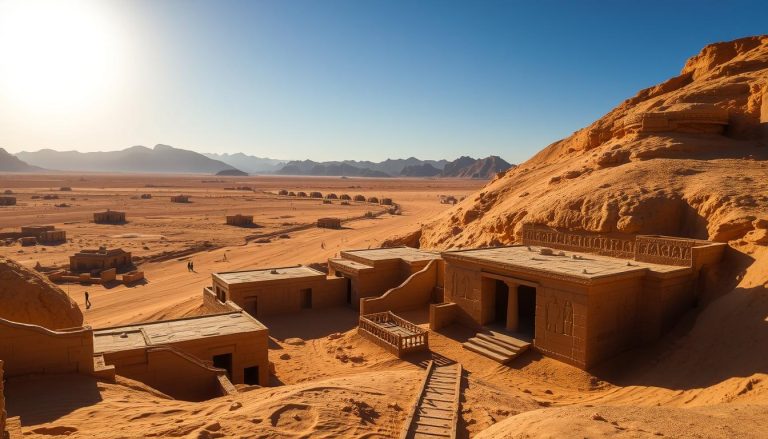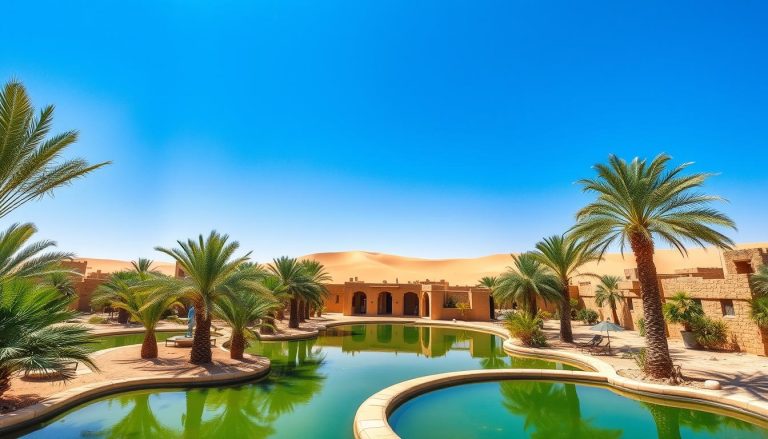Ever dreamed of seeing Egypt’s ancient wonders? Abu Simbel is a must-see. It’s on Lake Nasser’s banks, with twin temples built over 3,000 years ago by Pharaoh Ramesses II. What secrets do these huge structures hold? And why are they so famous in Egypt?
Key Takeaways
- Abu Simbel is home to the Great Temple of Ramesses II and the Temple of Queen Nefertari, both UNESCO World Heritage sites.
- Construction of the temples took 20 years and was completed in 1244 BC under Ramesses II’s rule.
- The entire complex was relocated to higher ground in the 1960s due to the threat of rising water levels from the Aswan High Dam.
- Visitors can explore the impressive interiors, intricate carvings, and colossal statues that showcase the architectural marvel of ancient Egypt.
- Abu Simbel offers unique opportunities to witness the sun festival celebrations and experience the site’s breathtaking natural setting on Lake Nasser.
Overview of Abu Simbel's Historical Significance
The Abu Simbel temples sit on the Nile River’s banks. They show the power and grandeur of ancient Egypt. These huge structures were built by Pharaoh Ramesses II, revealing the historical significance and archaeological wonders of the Nubian culture.
The Story Behind the Ancient Complex
The temples were built during Ramesses II’s rule, either in 1264 BC or 1244 BC. It took about 20 years to finish them. They were meant to honor the pharaoh and show Egypt’s strength. For a long time, they were lost, hidden by sand, until found in the early 19th century.
Architectural Marvel of Ancient Egypt
The complex has two temples: the Great Temple for Ramesses II and the Small Temple for Queen Nefertari. The Great Temple has huge statues of the pharaoh, 66 feet tall. The Small Temple has statues of Ramesses II and Nefertari, each 33 feet tall.
UNESCO World Heritage Recognition
The Abu Simbel temples were named a UNESCO World Heritage Site in 1979. This honor highlights their historical significance and archaeological value. It shows the world’s commitment to saving these ancient treasures, which still amaze and inspire people today.
| Fact | Statistic |
|---|---|
| Cost of Relocation Effort | Over $40 million ($300 million today) |
| Height of Colossal Statues | Great Temple: 66 feet, Small Temple: 33 feet |
| Abu Simbel Sun Festival | Attracts thousands of visitors annually on Oct. 22 and Feb. 22 |
| Entry Fee | 160 Egyptian pounds ($10) per adult |
| Temple Opening Hours | 6 a.m. to 5 p.m. (Oct-Apr), 6 a.m. to 6 p.m. (May-Sep) |
The Abu Simbel temples show ancient Egypt’s engineering and cultural achievements. They amaze visitors with their historical significance, architectural marvels, and Nubian cultural heritage.
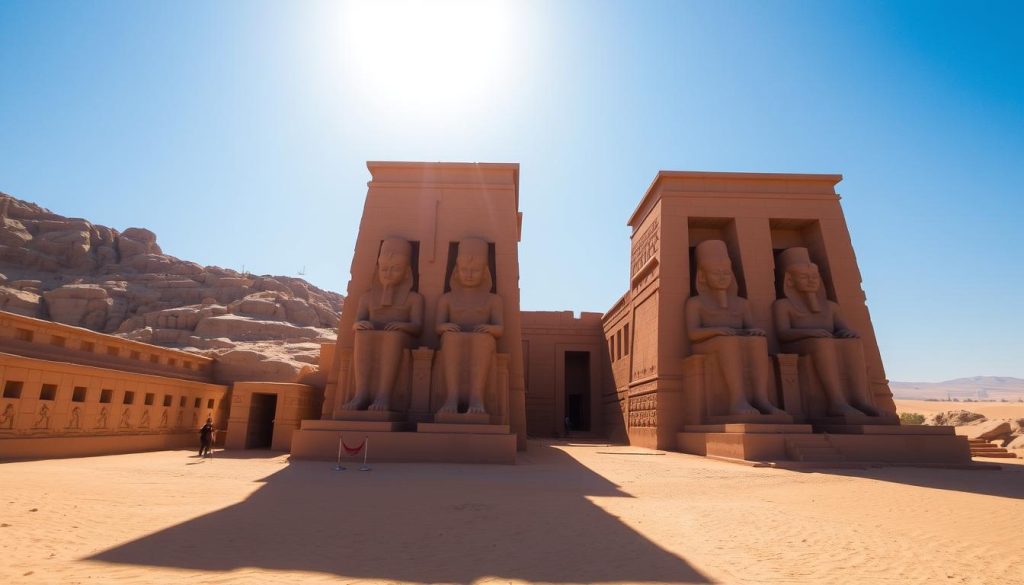
The Great Temple of Ramesses II
In the heart of Abu Simbel, the Great Temple of Ramesses II is a marvel. It shows the huge dreams and skill of ancient Egypt. The temple, carved into the mountainside, has four huge statues of the pharaoh. Each statue wears the double crown of Upper and Lower Egypt.
Walking into the temple’s hypostyle hall, you see eight massive pillars. They show Ramesses II as the god Osiris. The walls tell the story of the Battle of Kadesh, a famous victory of the pharaoh.
The inner sanctuary is the temple’s greatest wonder. Here, you find statues of gods Ra-Horakhty, Ramses, Amun Ra, and Ptah. On October 22nd and February 22nd, the sun shines on these statues, lighting them up.
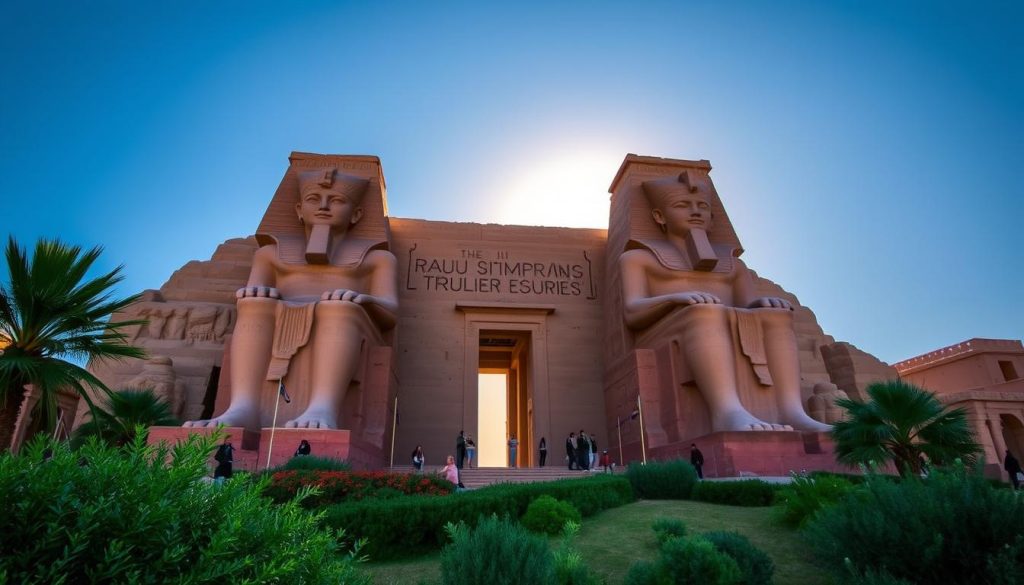
This engineering and art show the lasting impact of Ramesses II and ancient Egyptians. Exploring the Great Temple, you feel like you’ve traveled back in time. You marvel at the huge scale and detail of these ancient wonders.
| Architectural Highlights | Significance |
|---|---|
| Colossal Statues of Ramesses II | Representing the pharaoh’s power and divinity |
| Hypostyle Hall with Pillars | Depicting Ramesses II as the god Osiris |
| Inner Sanctuary | Featuring seated figures of revered deities |
| Solar Alignment | Allowing sunlight to illuminate the sanctuary on specific dates |
The Great Temple of Ramesses II is a symbol of ancient Egypt’s lasting legacy. It draws visitors with its statues, hypostyle hall, and inner sanctuary. Discover the history and marvels of this architectural wonder.
The Temple of Queen Nefertari
The Temple of Queen Nefertari is a marvel next to the Temples of Abu Simbel. It shows the importance of Egyptian queens in ancient times. Dedicated to Hathor and Queen Nefertari, it’s a special part of the Abu Simbel complex.
Architectural Features and Design
The Temple of Nefertari is known for its mix of big and small details. The statues of Ramesses II and Nefertari are the same size, showing her importance. Inside, a hall with six pillars has Hathor’s head on each, symbolizing joy and motherhood.
The heart of the temple is for Hathor worship. This shows its deep religious and cultural value.
Symbolism and Religious Significance
The Temple of Queen Nefertari is more than just a building. It shows ancient Egyptian beliefs and spirituality. It aligns with the sun during special times, linking it to the heavens.
The carvings and murals tell of the queen’s faith in gods. They show the temple as a place where heaven meets earth.
Ancient Egyptian Artistry
The queen’s temple walls are filled with amazing Egyptian art. The colors, reliefs, and scenes bring the Ramesside era to life. They show the queen and her husband in rituals and gods and myths.
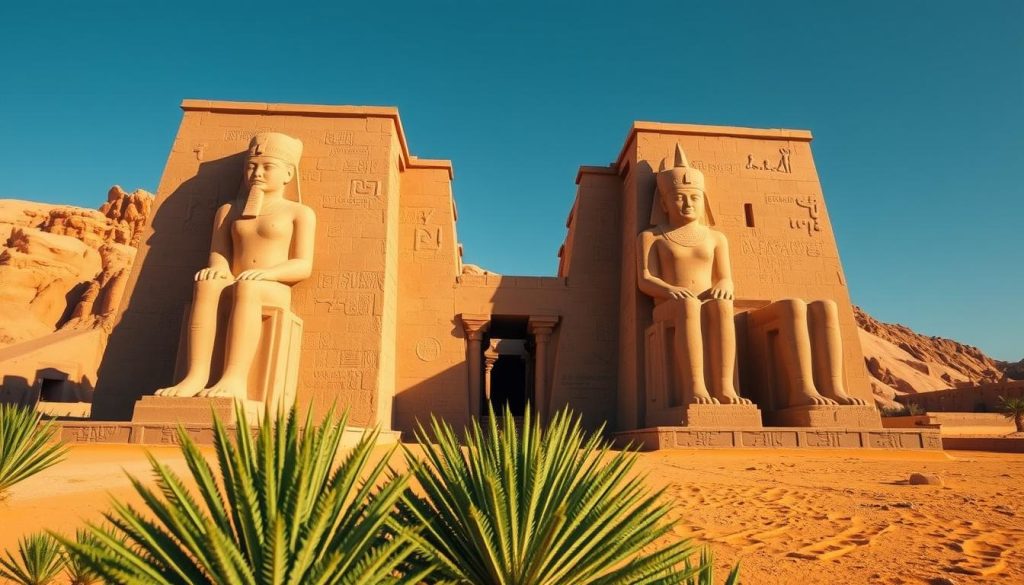
“The Temple of Nefertari stands as a testament to the enduring power and significance of the queen’s temple in ancient Egyptian society, where the divine and earthly realms converged in a stunning display of architectural and artistic excellence.”
Abu Simbel, Egypt: Best Things to Do - Top Picks
Abu Simbel is a key spot in southern Egypt for history and culture fans. It’s famous for its ancient temples built over 3,000 years ago by Ramesses II. Here, you can see the amazing architecture and learn about ancient Egypt’s beliefs.
Seeing the sun light up the Great Temple of Ramesses II is a highlight. This happens twice a year, on the pharaoh’s birthday and coronation day. It’s a big draw for those wanting to see this special solar event.
- Explore the well-preserved bas-reliefs and colossal statues adorning the temple’s exterior, showcasing the artistic prowess of ancient Egyptian craftsmen.
- Marvel at the engineering feat of relocating the entire Abu Simbel complex to higher ground, a UNESCO-led project that saved the site from being submerged by the rising waters of Lake Nasser.
- Visit the Temple of Queen Nefertari, a smaller but equally impressive structure dedicated to the pharaoh’s beloved wife, and admire the intricate paintings and symbolism within.
Abu Simbel is perfect for history lovers, architecture fans, or anyone looking for a unique cultural experience. It’s a top spot in Egyptian tourism. This ancient wonder is a must-see for anyone exploring the Nile Valley.
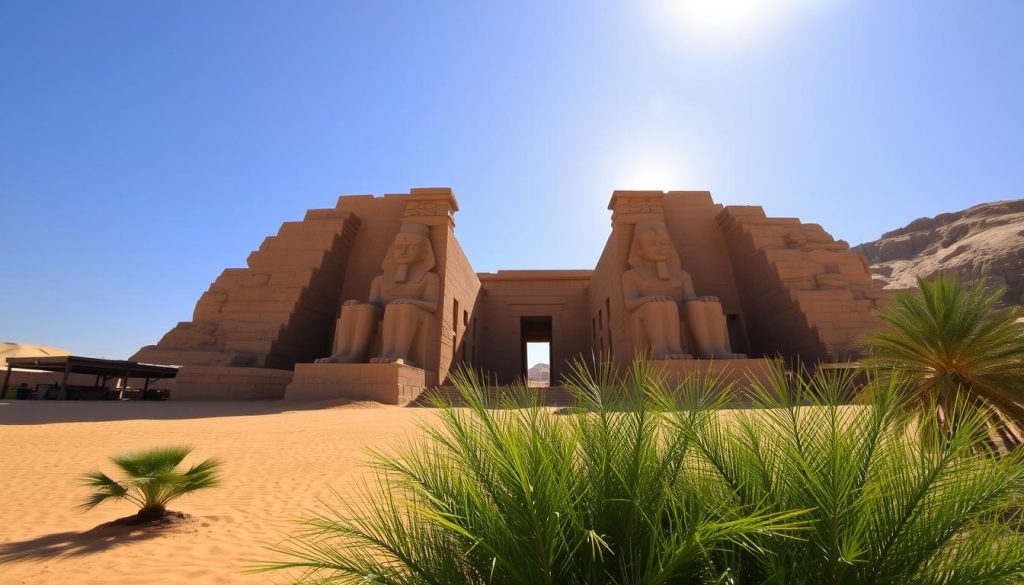
| Statistic | Value |
|---|---|
| Distance from Aswan | 280 kilometers |
| Transport Time from Aswan | 3 hours |
| Construction Timeline | 20 years, completed in 1244 BC |
| Relocation Project | Over 50 countries, 5 years of work |
Best Time to Visit and Solar Phenomena
Choosing the right time to visit Abu Simbel in Egypt can greatly enhance your experience. The Abu Simbel sun festival happens twice a year. It takes place on October 22nd and February 22nd. On these days, the sun lights up the Great Temple of Ramesses II, creating a stunning sight.
Sun Festival Celebrations
Visiting during the sun festival is unforgettable. The temple’s design aligns with the sun’s rays, filling the inner sanctum with light. This event draws visitors from all over, offering a unique cultural experience.
Weather Considerations
The best time to visit Abu Simbel is from October to April. The Egyptian climate is milder and more comfortable during this period. Summer months are very hot, especially in the south.
Visiting in late November to late February means you’ll see more people. But the weather is perfect, with temperatures between 65-85°F (18-29°C).
Peak vs. Off-Peak Seasons
For fewer crowds, visit from March to May or September to November. These shoulder seasons are less busy, with mild weather. But, summer can be extremely hot, reaching up to 42°C (108°F).
Planning your trip to Abu Simbel in advance is key. It ensures you enjoy this ancient Egyptian site to the fullest.
Getting to Abu Simbel: Transportation Options
Abu Simbel is 300 km south of Aswan. You can get there by flight, bus, or private car. The fastest way is by flying from Aswan, which takes 45 minutes and costs $150 to $325 each way.
For a cheaper option, take a bus from Aswan. It takes 4 hours and leaves at 8 AM. The bus costs less, but the trip is longer. You’ll pay about 600 EGP to enter Abu Simbel.
Some people fly from Cairo to Aswan first. This can cost $200 to $500 per person. It lets you see more of Egypt.
You can also hire a private driver or join a shared tour. A private car costs 3,500 to 3,800 EGP for three people. Shared tours are 180 to 300 EGP per person.
The road convoy system runs twice a day. It leaves Aswan at 4 AM and 11 AM. The return trip from Abu Simbel leaves by 4 PM. This gives you two hours to see the temples.
Visiting Abu Simbel is a highlight of any Egypt trip. It showcases ancient Egyptian history and architecture. It’s a must-see for anyone interested in history and culture.
Guided Tours and Visitor Experience
Guided tours make exploring Abu Simbel’s ancient wonders even more exciting. These tours provide deep insights into the site’s rich history and cultural importance. They cover everything from transportation to entrance fees, ensuring a smooth visit.
Tour Package Options
Abu Simbel tours offer various packages for different tastes and budgets. You can pick from day trips, multi-day tours, or visits combined with other Egyptian spots. These packages include transportation, guides, and tickets, making your trip easy and worry-free.
Photography Tips and Regulations
Photography is allowed in the Abu Simbel temples, letting you capture their grandeur. But, flash use inside might be limited to protect the ancient art. It’s wise to check the latest photography rules before you go to enjoy your visit.
Local Guide Benefits
Hiring a local guide can really boost your Abu Simbel experience. They share fascinating facts about the site’s history, design, and hidden gems. Their knowledge brings the ancient complex to life, making your visit both educational and thrilling.
A visit to Abu Simbel usually lasts about 90 minutes. This gives you enough time to see the structures, admire the carvings, and feel the awe of Ramses II’s statues. Whether you join a guided tour or go solo, the experience is unforgettable.
Exploring Lake Nasser and Surrounding Areas
The Nubian region around Lake Nasser is full of wonders. Lake Nasser, the second-largest man-made lake, stretches over 500 kilometers. It offers a chance to see ancient temples and learn about local culture and history.
Discovering Nubian Wonders
Abu Simbel is famous, but the Nubian region has much more. Places like Philae Temple in Aswan and the Monastery of St. Simeon are must-sees. Lake Nasser cruises let you explore these sites and learn about Nubian culture.
Exploring Aswan and Beyond
Aswan is a lively city at the Nile’s edge. It’s a great place to dive into local culture and visit the Nubian Museum. The Nubian City, with its ancient and modern mix, is also worth exploring. It’s home to many historical sites, like the Monastery of St. Simeon and the Tombs of the Nobles.
| Nearby Attractions | Highlights |
|---|---|
| Philae Temple | Dedicated to the goddess Isis, this temple complex was built between 380 BC and 362 BC and features intricate carvings and reliefs. |
| Monastery of St. Simeon | This 7th-century Coptic monastery showcases the region’s rich architectural heritage and religious history. |
| Tombs of the Nobles | These ancient tombs, dating back to the Old Kingdom of Egypt (2686–2181 BC), offer insights into the daily life of ancient Egyptians. |
Looking to learn about Nubian culture or see Lake Nasser’s beauty? This area offers a journey through Egypt’s history and heritage. It’s an unforgettable experience.
Conclusion
The Abu Simbel Temples showcase ancient Egyptian ingenuity and art. They offer a unique Abu Simbel experience. Visitors can dive into the past’s mysteries.
Exploring the grand Temple of Ramesses II or the exquisite Temple of Queen Nefertari is unforgettable. A trip to Abu Simbel leaves a lasting impression.
As you explore these structures, you’ll appreciate ancient engineering and culture. Abu Simbel is a key to understanding Egypt’s rich heritage. It reveals the country’s architectural wonders and historical stories.
Visiting Abu Simbel can be part of a guided tour or an independent Egypt travel journey. The experience is captivating and memorable. So, pack your bags for an unforgettable adventure at this ancient site.
